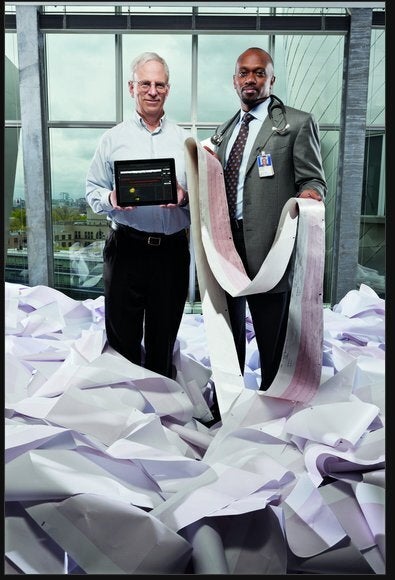
Here’s a little data about Rick Smolan, the pioneering photographer behind an ambitious and unprecedented multimedia portrait of big data.
He has a thick, black mustache that matches his thick, black head of hair. Jimmy Wales thought about renting his cottage in California. Smolan, born and raised in New York, lives on New York’s Upper West Side. He likes to use metaphors. He wears a UP wristband that tracks his sleep patterns and tattles on him when he fails to hit his 10,000 steps-a-day goal. He has a 12 year-old daughter who talked her way backstage to meet One Direction and a 9-year-old son who helped him figure out how to translate a buzzword -- big data -- into something meaningful.
“It’s like you spent your whole life looking through one eye and all of a sudden you open a second eye. You’re not just getting more vision. You’re getting another dimension,” Smolan says he told his son when the boy asked about his father's big data fascination. “We have 3D vision for the first time as a species.”
According to Smolan, if our conversation happened a few years from now, I’d have remembered quite a bit more, thanks to all-seeing, all-remembering devices that could have turned that little data captured by my fallible human brain into big data capable of analyzing every word and every pattern of our conversation. Whether that’s a good or bad, however, is up for debate.
Smolan, the creator of the trailblazing “Day in the Life” series whose forthcoming seven-pound book “The Human Face of Big Data” seeks to personalize this information explosion, sees big data only getting bigger.
"Big data," the internet-fueled explosion of enormous data sets that can be analyzed for trends and correlations, will soon inundate our daily lives, Smolan says. He predicts that not long from now, we’ll all wear devices capable of capturing three-dimensional “snapshots” of every room we’re in, every individual we meet and every sound we hear to ensure we never forget a person, place or talking point.
“Literally, you’ll have a way able to recreate a room almost like the Holodek on Star Trek,” explains Smolan. “For almost every moment, it will start being like there really is a time machine where you can step back in time to any moment.”
Flawless memory isn’t necessarily a good thing, acknowledges Smolan, who notes he much prefers snapshots -- a silent, limited view of a moment in time that “symbolizes all this emotion” -- to videos -- which have much more information, but, to Smolan, are less memorable.
“I think we’re going to have auxiliary hard drives to offload our memories,” says Smolan. “But part of what’s nice about being human is the self-deception and the processing of all of it. So it isn’t just every moment, but the synthesis of it. We walk away from this meeting we just had and we have a feeling of it, rather than thinking about every second of it.”
Perhaps consciously trying to remember an event and capture it for posterity actually decreases what we pick up in the moment, he ventures. Smolan recalls photographing a woman who spent nine months trekking across Australia with only a dog and a few camels. Smolan told to her to keep a journal so she could write a book about the experience, but she laughed off his suggestion.
“She told me, ‘I can tell by looking at your eyes that you’re thinking about where you just were, what’s happening next, but you’re never here with me, in the moment.’ Two years later she wrote this book, and she remembered every line in every conversation we had, every pattern of ants in the sand. I was stunned and asked, ‘How did you do that?’” says Smolan. “She said, ‘Because I was actually present and you were never here. You were here with your journals, your tape recorder, your cameras, and you were never present in the moment.’”
Smolan’s portrait of big data showcases the innovators pioneering new forms of data collection, the researchers studying that data and the people whose lives are touched by the insights gleaned from the exabytes of information we generate.
There is Shwetak Patel, a computer scientist and entrepreneur who has developed a way for households to itemize precisely which gadgets gobble the most energy, and tech luminary Gordon Bell, whose wearable SenseCam snaps photos every few minutes. There are photos about Japan’s use of big data to sense earthquakes before they happen, technology used to track counterfeit medication in Africa and the surprising patterns about Singaporean taxi drivers uncovered by big data analysis.
As part of the project, Smolan is also releasing an app he hopes will help people experience big data firsthand: by answering a series of questions over a week-long period, users will be able to see how their habits compare to others’ and glean insights about how people behave. The free app will be released September 26, and includes sixty questions ranging from “Do you think people basically good or not?” to “How do you wake up in the morning?”
Though “The Human Face of Big Data” offers up numerous positive examples of big data’s big impact, Smolan says he’s “trying to spark a global conversation” because there “are some scary things going on in the world of big data, and we need to think about them.”
“It seems like we need to be thinking about who’s actually controlling all this information about us and how we get to drive through it,” says Smolan. “Why is everyone making money off of our data except us?”
See photos from "The Human Face of Big Data" below and watch Rick Smolan's interview with HuffPost Live

